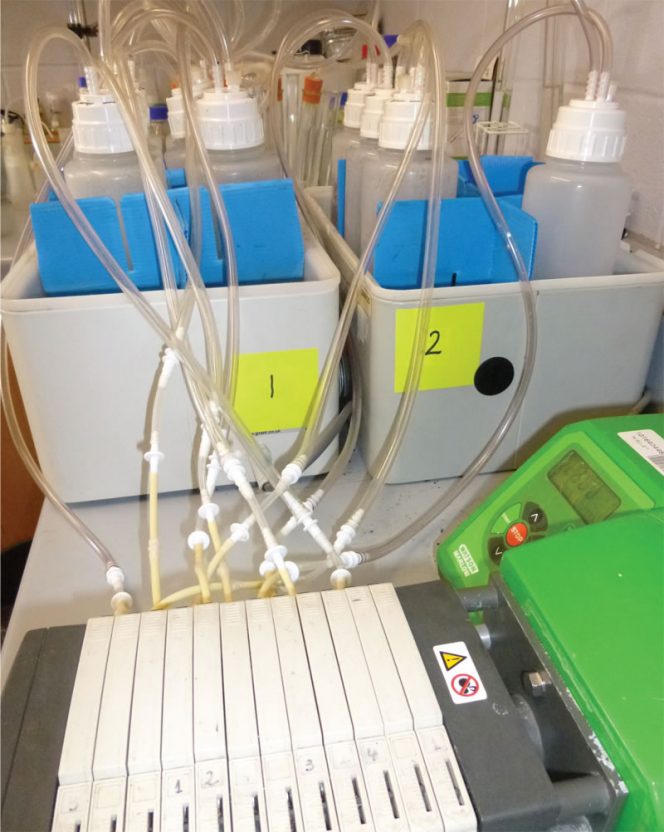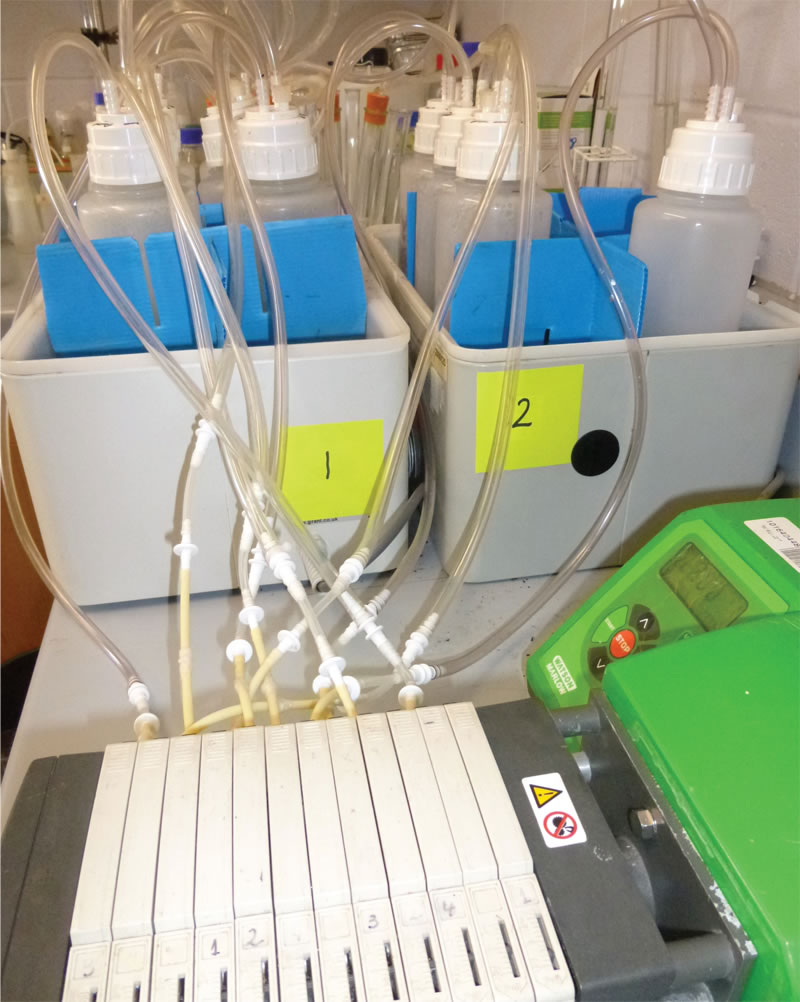Researchers evaluated use of a multichannel peristaltic pump to achieve more stable airflow rates across vessels, resulting in lower sample replicate variability.
Nora Goldstein
BioCycle February 2018

The diaphragm pump and peristaltic pump setups were established in the laboratory with either four or six vessels each. Photo courtesy of Thomas AsprayResearchers in the United Kingdom published a paper in an organic waste management special issue of Sustainability, titled “Improved Precision and Efficiency of a Modified ORG0020 Dynamic Respiration Test Setup for Compost Stability Assessment.” The authors, Diana Guillen Ferrari and Thomas J. Aspray at Heriot-Watt University in Scotland, and Graham Howell, at The Open University in England, compared performance of a diaphragm air pump and manifold, currently proposed in the UK ORG0020’s dynamic respiration test protocol, alongside an alternative pump type. This article is excerpted from the Journal paper.
Table 1 lists selected methods for determination of biological stability of compost samples. The UK ORG0020 test is used to assess compost stability as part of the compost certification scheme and adherence to BSI PAS100 Publicly Available Specification for Composted Materials. A dynamic respiration method, this test relies on a continuous supply of carbon dioxide (CO2) free air (maintained within a flow rate range of 25–75 mL min-1) over compost samples, and capturing the CO2 generated downstream in alkali traps. “A single aquarium diaphragm pump (in combination with a manifold for distribution) is proposed in the ORG0020 protocol to provide CO2 free air to the sample and control vessels; however, maintaining flow within the required range to typically 10 vessels in a single setup is difficult and requires (as a minimum) daily adjustment,” explain the authors. “If airflow falls outside of the required range, it may impact test accuracy and precision.
“In searching for a cost-effective solution, a multichannel peristaltic pump, commonly used for pumping water or aqueous based liquids, was considered as a possible viable option, the advantage being that dedicated pump channels provide air to individual vessels rather than distribute a single air supply to multiple vessels by way of a manifold.
“The aim of this work was therefore to determine whether the multichannel peristaltic pump approach could achieve more stable airflow rates across vessels, resulting in lower sample replicate variability (i.e., greater precision). Given the potential impact of this work on commercial laboratories, an assessment was made of the running cost of the multichannel peristaltic pump setup versus the original diaphragm pump setup on a consumables, equipment and staff time basis. Finally, we sought to analyze the oxygen demand of recently studied active samples to confirm whether the airflow range for the test remained acceptable.”
Materials And Methods
The researchers collected finished and unfinished compost samples from three PAS100 certified sites to give samples with a range of stabilities. Collected bulk samples were screened (as necessary) to ≤20 mm and stored at 4°C prior to characterization and stability testing. Characterization of compost samples was limited to dry matter (DM), electrical conductivity (EC), pH and organic matter (OM). (All characterizations utilized BS EN protocols for compost sampling.)
Two peristaltic pumps (Watson Marlow) — a 502S with maximum 100 rpm and a 520 with maximum 220 rpm — were trialed in this work for the modified setup. The 520 pump was only used for running the cost analysis.
The original (diaphragm pump) and modified (peristaltic pump) setups were established with either four or six vessels each. “This enabled a single compost sample to be analyzed with three replicates (as used in the test routinely) or five replicates alongside a control vessel containing no compost,” explain the authors. “Single outlier results were removed from both original and modified results where five replicates were used.
“The ORG0020 protocol specifies a three-day equilibration period with aeration applied to samples but without CO2 determination. Tests are routinely set up on a Friday with no measurements taken on days 1 and 2. Experiments 1 and 2 were run to assess airflow during the equilibration period with airflow measurements taken on days 0 and 3 to 4. Experiments 4–10 were run following the standard test method, with air flow measurements taken on days 0, 3, 4, 5, 6 and 7 and CO2 collection vessels measured on days 4, 5, 6, and 7.
“The exception to this was experiment 3 where only the original setup was run with seven vessels, enabling a single compost sample to be analyzed with six replicates alongside the control vessel. On day 2, the flow was intentionally lowered to <10 mL min-1 in three of the six vessels containing samples to further demonstrate the impact on CO2 determination on the first CO2 measurement (day 4). The other three vessels with compost were adjusted on day 2 within the 45–50 mL min-1 as necessary.”
Results
The following is excerpted verbatim from the results section of the Sustainability journal paper:
Flow Rate Consistency
Results show for equilibration only experiments and full-length experiments that the peristaltic pump setup was more consistent at maintaining airflow to all vessels within the required 25 to 75 mL min-1. In fact, flow was maintained in this range in the modified setup for all experiments except for one where a reading of 24 mL min-1 was recorded in one vessel on day 4. By comparison, the original test setup using an aquarium (diaphragm) pump and manifold failed to maintain flow to all vessels within the required range in all but one experiment (no. 7). Typically, airflow rate fell out of the required range at least once for one or more vessels per experiment. Where this occurred during the sample equilibration period (0–3 days), the length of time may be anything up to 72 hours (unmonitored over the weekend). Airflow rates falling out of range between days 4 to 7 may be up to 24 hours in duration assuming once daily checking.
Equilibration Period Air Flow Variability on Measured CO2
Airflow rates fell outside of the required range for the original setup in both short-term experiments (nos. 1 and 2) looking at the test equilibration period only, the result of which had a clear effect on the reported precision of compost stability by the original setup for experiment 1 and a lesser effect in experiment 2.
To provide further evidence of the impact of airflow falling out of range during the equilibration period, an additional experiment (no. 3) was considered — specifically, the air flow was adjusted to <10 mL min-1 on day 2 in three vessels and returned to within range (45–50 mL min−1) after changing water in the collection vessel to sodium hydroxide. The other three vessels were maintained within 45 to 50 mL min-1 range. The vessels subjected to the reduced airflow reported higher CO2 on the first measurement (day 4).
Overall Test Result Precision
Given the greater variability in airflow rate in the standard setup, comparison of test setup precision was assessed using three different composts of varying stability. Initial experiments (4, 6 and 7) were carried out using triplicate sample vessels. However, this was increased to quintuplicate for experiments 9 and 10 to minimize the potential impact of heterogeneity of more active samples, with a single outlier measure removed from each setup equally for these experiments. With this approach, the results show that the modified setup derived stability value was consistently more precise than that generated with the original setup.
Running Cost Comparison
The comparison shows that the additional electricity and tubing costs of the modified (peristaltic pump) setup are easily offset by the reduced labor of the diaphragm pump, making it comparatively more cost-effective. The modified setup was more cost-effective using the 520 series (max 220 rpm) pump.
Air (Oxygen) Demand of Industry Compost Samples
Analysis of the oxygen demand of industry compost samples was carried out using data collected as part of previously published work but until now unreported (Aspray et al, 2015). This provided a detailed time series of oxygen consumption over the full three days of preincubation time and four days of active testing. Throughout all these tests, oxygen content in the exhaust gas remained above 16 percent (lowest about 18.5%). This is assumed to be fully aerobic and thus nonlimiting to decomposition during the test.
Three of the samples tested were found to pass the PAS100 stability limit of 16 mg CO2 g-1 VS d-1 and these showed low oxygen demand throughout the seven days. Two samples were above the stability limit and oxygen demand for these samples peaked around day 2 (in the equilibration period) and day 5 (during the test period).
In the range where airflow is sufficient to satisfy the maximum oxygen demand, it is expected that the only effect of changing flow rate is changing the dilution of the exhaust gas with fresh air. Using this assumption, the equivalent flow rates required to maintain oxygen content of the outlet gas at 15 percent and 10 percent throughout the ORG0020 test were calculated. These levels are chosen to represent fully aerobic, and possibly borderline aerobic, conditions, following Ahn et al. (Ahn et al., 2007). The flow rate required to maintain 15 percent oxygen in the outlet at maximum oxygen demand was approximately 23 mL min−1 100 g-1, and for 10 percent oxygen, 13 mL min-1 100 g-1.
Conclusions
The following were cited as conclusions of this research, excerpted verbatim from the journal paper:
- Low flow (<10 mL min−1) during the three-day equilibration period causes the build-up of CO2 in sample vessels, which can lead to higher reported CO2 or increased replicate variability (depending on the number of nonconforming vessels) on measurement day 4.
- Using three- and five-sample replicate experiments, we [researchers] provide a robust dataset supporting improved precision of the modified setup.
- Tests conducted at 30°C indicate that the reported 0.906 mg CO2 g−-1 OM d−-1 “pooled” standard deviation is a useful baseline for validating setups with stable samples but is not upheld with more active and inherently heterogeneous samples.
- With reduced labor time for airflow adjustment and monitoring, the modified setup has potential for lower running costs.
- Respirometer tests indicate that a consistent flow rate of 25 mL min−1 or above is expected to provide sufficient flow in this test for a 100 g fresh weight sample.











